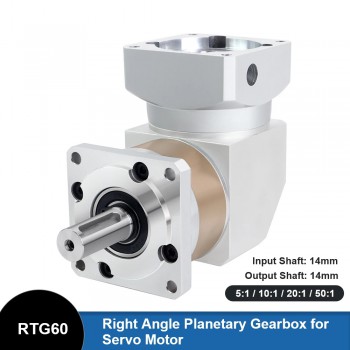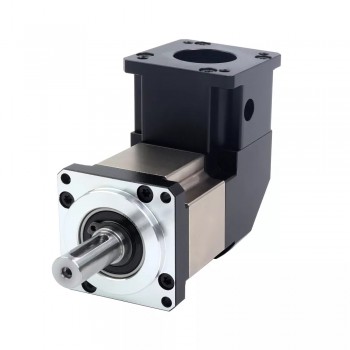1.Brief of right angle planetary gearbox
A right angle planetary gearbox combines the 90-degree shaft angle of a right-angle gearbox with the high-efficiency, compact, and high-torque characteristics of a planetary gearbox. This allows for power transmission between perpendicular shafts in a compact, space-saving design, making them ideal for applications with limited room where high performance and torque are needed. They are built with a multi-stage design, often using helical or bevel gears for the initial right-angle stage and a planetary gear set for the reduction.

2.Working steps of right angle planetary gearbox
1.Input: Power is supplied to an input shaft. In a right-angle planetary gearbox, this shaft is typically connected to a bevel gear or an input bevel pinion.
2.Right-angle conversion: The input bevel gear turns the planet gears at a 90-degree angle.
3.Planetary action: The planet gears are held in a carrier and are also driven by a central sun gear. As the planet gears are rotated, they also orbit around the sun gear while meshing with the internal teeth of a ring gear.
4.Load distribution: This multiple-gear arrangement allows the load to be shared across several contact points, resulting in increased durability and efficiency.
5.Output: The output is delivered by the carrier, which holds the planet gears. Because the planet gears are orbiting and also spinning, the carrier provides a high-torque output, often with a significant speed reduction.
3.Structural advantages of right-angle planetary gearboxes
1.Compact design: The right-angle planetary gearbox adopts a modular design, which is small in size, light in weight, and easy to install and maintain. Its compact right-angle layout allows the input shaft to be arranged vertically with the output shaft, which can achieve effective power transmission in a limited space and save installation space.
2.Efficient transmission: The planetary gear system has the characteristics of multi-tooth meshing, which can achieve smooth and efficient transmission and reduce energy loss. In addition, the transmission efficiency of the planetary gear reducer is high due to multi-gear split transmission, internal meshing, compact structure, smooth movement and the use of high-strength materials.
3.High load-bearing capacity: The planetary gear system can evenly distribute the load, improve the load-bearing capacity of the reducer and extend the service life. The structure of the planetary gear reducer is compact, and the reasonable layout of the planetary gear, sun gear and internal gear ring reduces the distance and loss of power transmission.
4.Multiple installation options: The right-angle planetary gearbox combines the advantages of compact right-angle gearboxes and traditional planetary gearboxes, and provides a variety of installation options for different application scenarios.Its output shaft can choose an output shaft with a key to improve safety, or a smooth output shaft for press-fit transmission.
5.High precision and low backlash: Some models of right-angle planetary gearboxes provide high positioning accuracy, especially in reverse mode, suitable for applications that require high-precision transmission.

4.Methods of improving stablity of right angle planetary gearbox
1.Improve housing and structural rigidity: A rigid, stable housing prevents flexing and deflection under heavy loads, which is critical for maintaining gear alignment and reducing vibration.Use robust materials like high-strength steel or cast iron for the housing.Integrate reinforcement ribs and strengthen connection points to reduce stress and prevent deformation.Perform Finite Element Analysis (FEA) during the design phase to identify potential stress concentrations and vibration patterns.
2.Optimize gear design and meshing: Precisely designed gears minimize impact, backlash, and meshing errors, which are major sources of instability.Use high-precision tooth profiles and helix angles to promote smoother engagement and reduce impact and vibration.Carefully control the tooth side clearance during assembly to mitigate the impact noise caused by sudden direction changes.Consider modifying the tooth flanks to reduce transmission error, which is a key cause of internal vibration.
3.Enhance load distribution: Uneven load distribution among the planet gears is a primary cause of instability and premature wear.Utilize a flexible pin or floating design,floating sun gears and planet carriers can absorb manufacturing and assembly errors, ensuring the load is evenly shared across all planet gears.Employ load-balancing mechanisms,these systems automatically adjust to achieve a more uniform distribution of force among the planet gears.
4.Strengthen bearing support and alignment: Proper bearing selection and precise alignment are fundamental to managing loads and ensuring smooth, stable rotation.Use high-performance bearings, such as preloaded tapered roller bearings, to support high radial and axial loads. In contrast, standard cylindrical bearings with clearance can lead to unequal load sharing.For applications involving high radial or axial loads on the output shaft, use external bearing blocks to support the shafting and prevent stressing the gearbox’s internal components.Reducing the clearance in the sun gear and carrier bearings can significantly improve the vibration response and stability.